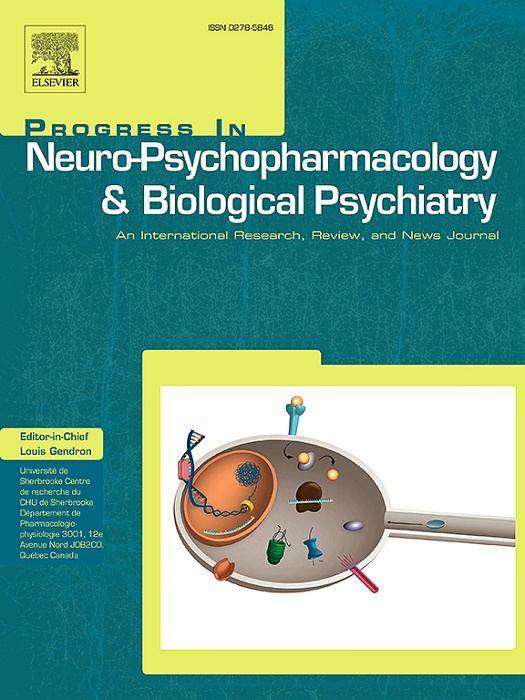精神分裂症个体形态变形的空间模式:未受影响的兄弟姐妹的皮质假定代偿性
IF 5.3
2区 医学
Q1 CLINICAL NEUROLOGY
Progress in Neuro-Psychopharmacology & Biological Psychiatry
Pub Date : 2025-03-14
DOI:10.1016/j.pnpbp.2025.111329
引用次数: 0
摘要
神经影像学的进步揭示了各种指标的形态变形,阐明了精神分裂症的神经病理起源。然而,整合各指标的研究结果并在个人层面评估区域全球变形构成了重大挑战。方法利用包含三个关键指标(皮质厚度、旋转和体积)的距离算法,我们提出个体形态变形指数(IMDI)作为精神分裂症的潜在生物标志物,并将其应用于199名精神分裂症患者、218名健康对照和47名未受影响的兄弟姐妹。此外,我们还研究了多基因风险、症状、认知、社会功能与区域IMDI之间的关系。结果:我们的研究结果显示,患者的特定脑区(双侧小包部、外侧眶额、左侧顶叶上部、右侧眶部和颞上)的IMDI显著升高,显示出两种不同的空间模式,与孤立的指标降低或多个指标同时下降有关。值得注意的是,未受影响的兄弟姐妹表现出比对照组更高的IMDI,主要是由于右侧包部和颞上区皮质体积扩大。IMDI越高的患者阳性症状越严重,认知功能受损,社会功能和自我照顾能力下降。多基因得分较高的参与者表现出较高的IMDI,特别是在左尾侧中额叶区域。结论提出的IMDI生物标志物提供了一种客观、可解释的方法来量化全球区域变形并整合不同的神经影像学指标。我们的研究结果表明,与精神分裂症相关的皮质变形包括感觉运动、注意、默认模式和额顶叶网络,至少表现出两种空间模式。此外,兄弟姐妹可能在皮质体积上表现出代偿。这些见解为精神分裂症的神经解剖学基础提供了一个新的视角。本文章由计算机程序翻译,如有差异,请以英文原文为准。
Spatial patterns of individual morphological deformation in schizophrenia: Putative cortical compensatory of unaffected sibling
Background
Neuroimaging advancements have revealed morphological deformation across various indicators, illuminating the neuropathological origins of schizophrenia. However, consolidating the findings across indicators and assessing regional global deformation at individual-level poses a significant challenge.
Methods
We propose individual morphological deformation index (IMDI) as potential biomarker for schizophrenia leveraging a distance algorithm that incorporates three key indicators (cortical thickness, gyrification, and volume), and applied it for 199 schizophrenia patients, 218 healthy controls, and 47 unaffected siblings. Additionally, we studied the relationships between polygenic risks, symptomology, cognition, social functioning and regional IMDI.
Results
Our findings reveal significantly higher IMDI in specific brain regions (bilateral pars opercularis, lateral orbitofrontal, left superior parietal, right pars orbitalis, and superior temporal) in patients, demonstrating two distinct spatial patterns linked to either isolated indicator reduction or concurrent declines across multiple indicators. Notably, unaffected siblings exhibited higher IMDI than controls, primarily due to cortical volume expansion in the right pars opercularis and superior temporal regions. Patients with higher IMDI had more severe positive symptoms, impaired cognition, reduced social functioning and selfcare ability. Participants with higher polygenic scores showed higher IMDI specifically in left caudal middle frontal regions.
Conclusions
The proposed IMDI biomarker offers an objective, interpretable way to quantify global regional deformation and integrate disparate neuroimaging indicators. Our results indicate that schizophrenia-related cortical deformations encompass sensorimotor, attention, default mode, and frontoparietal networks, exhibiting at least two spatial patterns. Moreover, siblings may exhibit compensation in cortical volume. These insights offer a novel perspective on the neuroanatomical underpinnings of schizophrenia.
求助全文
通过发布文献求助,成功后即可免费获取论文全文。
去求助
来源期刊
CiteScore
12.00
自引率
1.80%
发文量
153
审稿时长
56 days
期刊介绍:
Progress in Neuro-Psychopharmacology & Biological Psychiatry is an international and multidisciplinary journal which aims to ensure the rapid publication of authoritative reviews and research papers dealing with experimental and clinical aspects of neuro-psychopharmacology and biological psychiatry. Issues of the journal are regularly devoted wholly in or in part to a topical subject.
Progress in Neuro-Psychopharmacology & Biological Psychiatry does not publish work on the actions of biological extracts unless the pharmacological active molecular substrate and/or specific receptor binding properties of the extract compounds are elucidated.

 求助内容:
求助内容: 应助结果提醒方式:
应助结果提醒方式:


